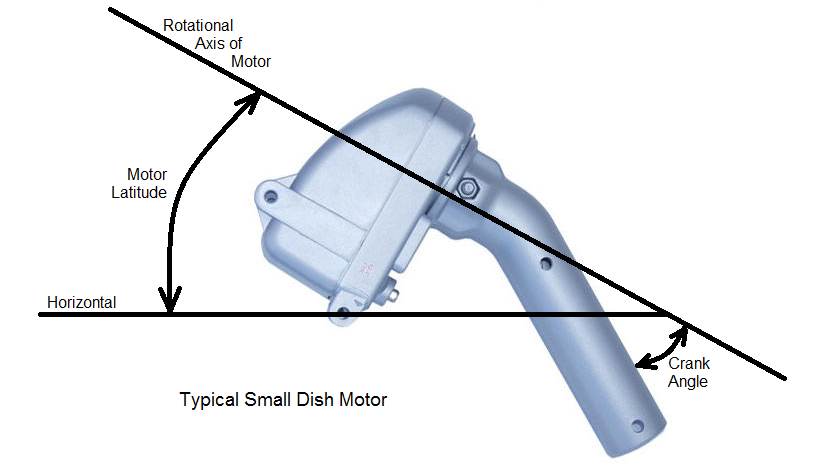
How to Install a
Motorized FTA Satellite TV System
How to Install a Motor on a Free To Air Satellite TV Dish for KU
Band and How to Align a Larger C band Polar Mount.
The alignment process for tracking the satellite arc for small dish KU
band and larger dish C band is very similar.
A motor allows you to turn the antenna to different satellites. A small dish KU
motor is operated through the single wire that normally runs from the receiver
to the LNB. The wire will now run from the receiver straight to the motor. Then
from the motor to the LNB.
C band polar mount normally uses a linear actuator to turn the dish and separate
wire and controller to power the actuator.
Before buying a small dish motor, try to decide which satellites you would like
to receive. Here are some Free to Air (FTA) channel lists:
http://www.sathint.com/
http://www.ftalist.com/index.php
http://www.lyngsat.com/
http://www.global-cm.net/MPEGlistKuBandUS.html
Check How Far Your Small Dish Motor Will Need to Turn
Go to Dishpointer.com and find your location and look up the farthest
east and farthest west satellite that you want. Note the azimuth for each and
calculate the angle amount turned from south. South is 180 degrees. For example
my farthest west satellite has an azimuth of 235 degrees. 235 minus 180 equals
55 degrees. My farthest east satellite is 22 degrees from south. Using the
larger number I need a motor that can turn at least 55 degrees from south. Small
dish motors are sometimes advertised by their total turning angle. I would need
a motor that has a total turning angle of at least 110 degrees. Just make sure
your motor can turn the amount that you need.
C band with linear actuator by design can only turn so far. The bigger the dish,
the longer and stronger the actuator must be.
Two Basic Angles Needed.
There are two angles you will need to set up the motor or the polar
mount. These angles are the same for both small dish KU band and larger dish C
band.
1. The Motor Latitude
2. Declination angle
These are two separate angles requiring two separate adjustments.
Small dish: The motor latitude is adjusted using the motor bracket that came
with the motor. The declination angle is set using the elevation scale on the
dish.
Large dish: For C band dish there are two separate adjusters, one for motor
latitude and one for declination angle.
Using the Dishpointer.com website, find your location and instead of selecting a
satellite, scroll down to the Motorized section and select True South / True
North. It will give you the motor latitude and declination angle for your
location. Write these down.

Rotational Axis and Motor Latitude
In the picture above, the rotational axis of the motor is the upper line.
The lower line shows horizontal. The Motor Latitude from
Dishpointer.com is the
angle above horizontal that the rotational axis is set. Notice the tube where
you mount the antenna is bent down from the rotational axis. This is called the
crank angle. This crank angle has no effect on tracking the satellite arc
sometimes called the Clarke Belt. It is the motor latitude in combination with
the declination angle that affects tracking of the satellite arc. In the
northern hemisphere you raise the north side of the motor.
In the drawing below is a prime focus dish. You use the same Motor Latitude and
Declination Angle that you obtained from dishpointer.com
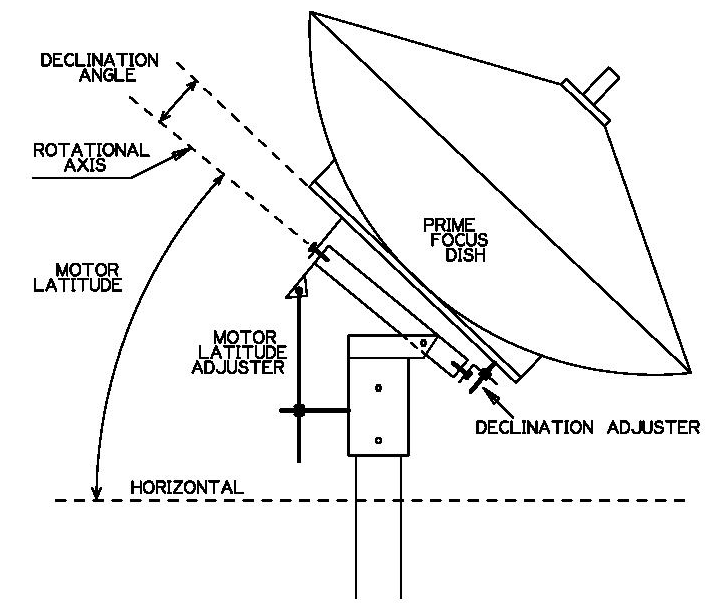
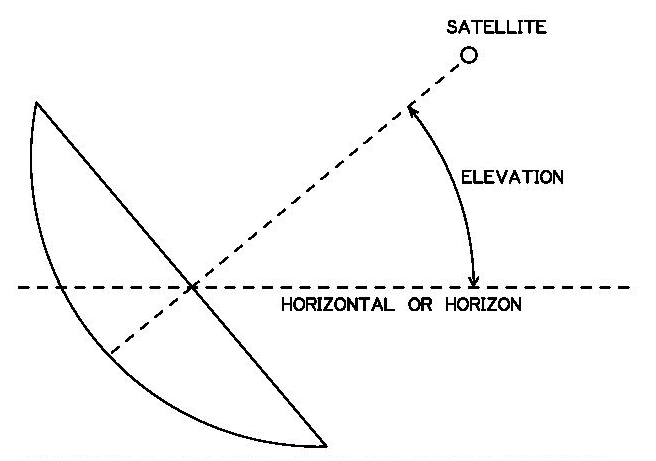
Elevation
Elevation is the angle above the horizon from your location that the satellite is located. This angle is the same for offset or prime focus dishes. Small dishes have elevation scales that show how far above the horizon the dish is focused for satellite signal reception.
How high the dish is pointed is also called the Elevation. Pointed straight at the horizon would be 0 degrees elevation. Straight up would be 90 degrees elevation. If you raise the antenna, pointing it higher in the sky, then you are raising the Elevation. As the antenna turns on the rotational axis the elevation changes to track the satellite arc in the sky. Due south from you in the middle of the arc, the elevation is highest. Turning east or west from there the elevation is lower. Obviously the elevation of your dish must match the elevation of the satellite.
Declination Angle
Small Dish: The declination angle is set using the elevation scale on
the dish. The elevation scale setting is always: The Crank Angle minus the
Declination Angle. If the crank angle is 35 degrees and the declination is 5.8,
you would set the elevation scale at 29.2. Read the numbers on the scale and set
accordingly.
Large Dish:
On larger C band type dish use the declination adjuster.
The drawings below show some angles involved for motor setup. The Motor
Latitude and Declination Angle are the important angles that you need.
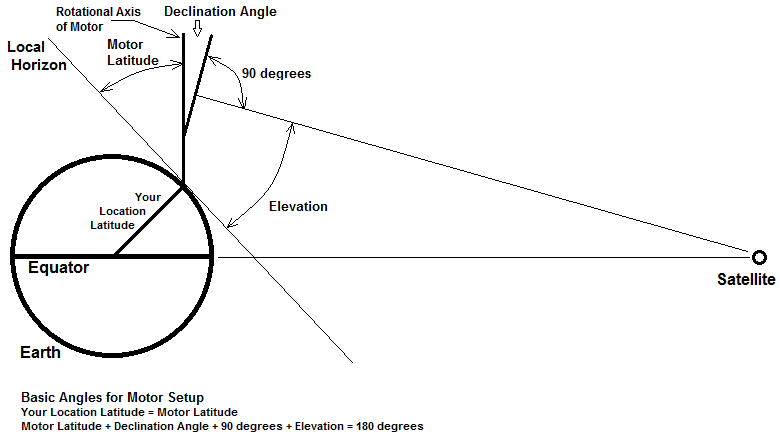
Here are the same angles presented slightly different:
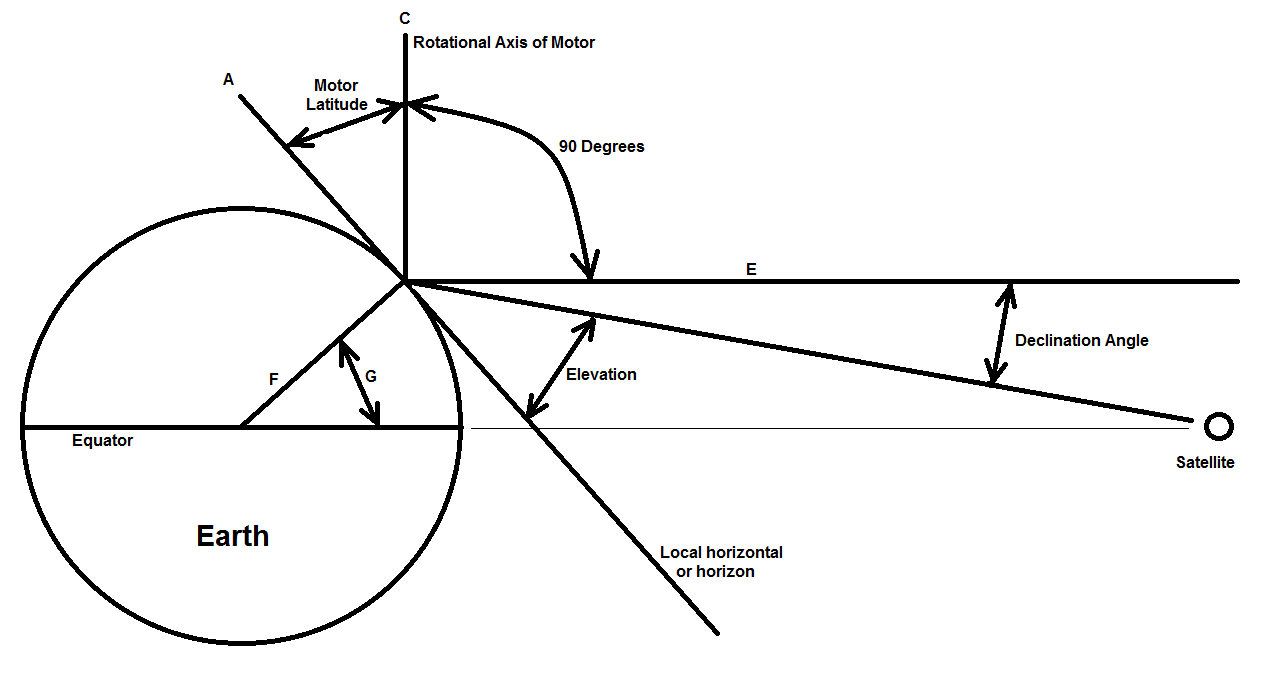
In the picture above, the
satellite is in line with the equator. Line F and Angle G is your latitude on
the earth. Line A is the local horizontal or horizon.
Line C is the rotational axis of the polar mount or the motor. The motor
latitude is exactly equal to Angle G. The antenna is attached to and rotates
with the rotational axis.
If the antenna looks out at exactly 90 degrees from the rotational axis (line E)
it would miss the satellite.
The Declination Angle is the amount the antenna has to be turned downward to
line up with the satellite. The closer you are to the equator, the smaller the
declination angle.
If you were right on the equator, there would be no declination angle and the
motor latitude would be zero and the elevation 90.
Here is one more drawing of the angles for offset dish:
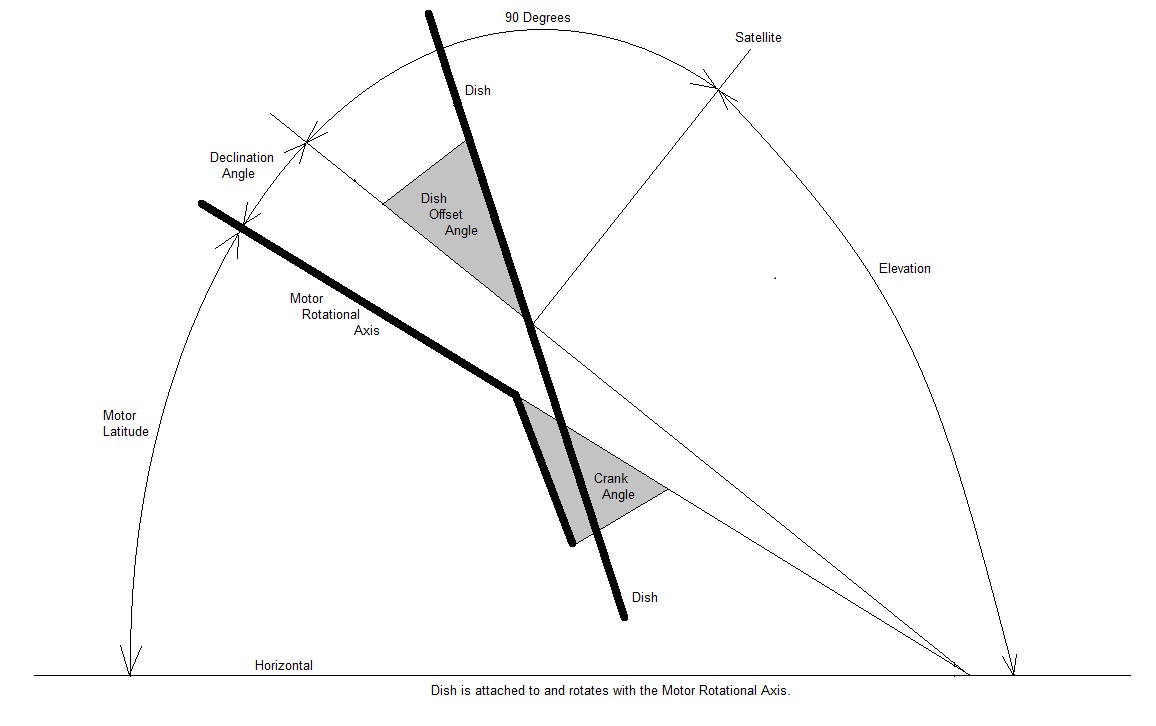
Mast Must be
Plumb
The mast that you mount the motor and dish or polar mount on must be
plumb, vertical.
Begin the Installation
Small Dish: Mount the motor on the mast and put a hose clamp on the mast
just below the motor bracket to hold the motor from slipping down the mast while
adjusting. Attach the antenna to the motor. Point the antenna and motor
approximately south.
Large dish: Assemble the dish to the polar mount.
Put the assembly on the mast and install the linear actuator.
North/South Alignment of Rotational Axis
The rotational axis of the motor must be aligned
North/South. The antenna should be pointing to south azimuth angle of 180
when at its highest elevation. If the motor axis/rotational axis is not aligned
north/south, the antenna will be at its highest elevation at some azimuth angle
other than south 180.
The following method of alignment manually verifies the antenna is at highest
elevation and manually sets the turn to the nearest south satellite, thus
aligning the rotational axis north/south. This is how you should align a C band
antenna.
For a small dish the USALS function is much easier than this
manual setting. For small dish skip to: Setting the Motor Latitude-Small Dish.
Begin Adjustment
Set the rotational axis roughly to a
North/South alignment. Find some points on the dish that you can measure to see
if the dish is level. Perhaps where panels join or where the LNB support
arms connect to the dish. In this position, when the antenna is
level across the EAST/WEST edges, then the antenna is at its highest elevation.
Use a bubble level you know is accurate or use a 1/2 inch transparent tube as a water level for maximum accuracy. As
mentioned earlier the antenna should be at its highest elevation when pointing
to south azimuth of 180 degrees. We will call this the antenna's south 180
position.
Turning the
Antenna for True South Setting
We will now turn the antenna from south 180 position to the azimuth of
your nearest south satellite. If the nearest south satellite has no useable
transponder then find the azimuth of the nearest south satellite that has a
useable transponder. We want to point to and tune in the nearest south
satellite. Your nearest south satellite is the one with the nearest longitude
location equal to your longitude location. Go to
Dishpointer.com and find your location
and look up satellites on either side of your longitude. The one with the
azimuth nearest 180 is your nearest south satellite. Note the azimuth and skew
angle because
you will have to turn your antenna to find that satellite. Turning the antenna
from its highest elevation point (south 180 position) to your nearest south
satellite azimuth will assure that the antenna is pointing true south when it is
returned to its highest elevation point. Do not simply point your antenna at a
satellite and call it south if the azimuth is not exactly 180. If you actually
have a useable satellite at south azimuth 180 degrees, then no turn is
necessary. You would just level the antenna across the east/west edges.
The turn angle is simply the skew angle
that you find at Dishpointer.com. Turn the dish from level either
East or West the amount of the skew angle. Standing behind the dish
looking south toward the satellite (these are northern hemisphere directions) if
your nearest south satellite has an azimuth angle above 180 then turn clockwise
or drop the west side of the dish. If your nearest south satellite has an
azimuth angle less than 180, turn the dish counter clockwise or drop the east
side of the dish. You use the motor to move the dish for turning this
angle.
Measure the east/west width of your antenna. Use a
Triangle Calculator to
find the amount to drop the edge from level. Enter the width of your antenna as
two sides of a triangle. Enter the skew angle you want to turn the antenna for the
angle where the two sides touch. Enter length in inches if you want the
calculated side in inches. Be sure to use at least 3 figures after the decimal
point.
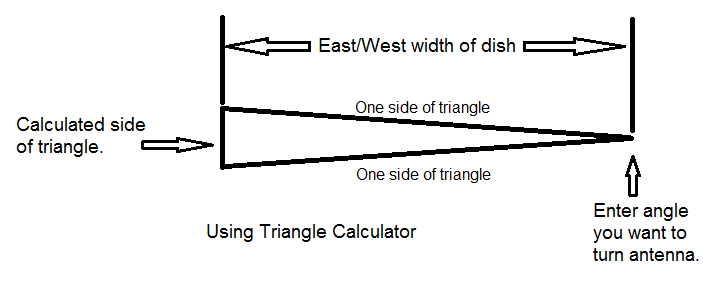
Measure your dish with a tape measure. For example, if you measure 120 inches, enter 120 for the two sides of the triangle. Enter the skew angle amount you need to turn, for example 0.5 degrees. The calculated movement would be 1.05 inches. Depending on which direction you need to turn, you would drop the east or west edge of the dish 1.05 inches. Do not use these numbers, they are examples only. Use the water level and a ruler to check the movement. AFTER SETTING THIS LITTLE ANGLE DO NOT USE THE MOTOR AND DO NOT TURN THE ANTENNA. You will turn the antenna for initial tuning of your nearest south satellite by turning the entire dish and polar mount assembly on the mast.
Move ONE HALF of the Calculated Turning Distance on each side. The dish pivots in the middle, so the distance to turn is divided between the two sides. One side of the dish goes up while the other side goes down. For an EAST turn, drop the EAST edge of the dish from level. For a WEST turn, drop the WEST edge of the dish from level.

If you use a level line and measure on one side only then you would measure the total turning distance as shown in drawing below.

Setting the Motor Latitude-Small Dish
Small Dish: Set the motor latitude using an angle
finder. Do not use either of the scales on the motor bracket. They are
notoriously inaccurate. The reading on the angle finder is simple. Starting from
horizontal, the movement is: The motor latitude angle plus the crank angle. If
you use the angle finder under the motor opposite the
antenna, you will still measure the same degrees from horizontal, but the angle
finder must be turned 180 degrees.
For example, using an angle finder as shown in the drawing below, if the motor
latitude is 40 degrees and the crank angle is 35, then the angle you want is 75. After adjustment tighten the little screws using a nut driver. Be careful not to
over tighten. These screws might strip out if you over tighten. Check the angle
again after you tighten the screws. If not correct, do over. This must be right.
Hopefully you will not have to reset this.
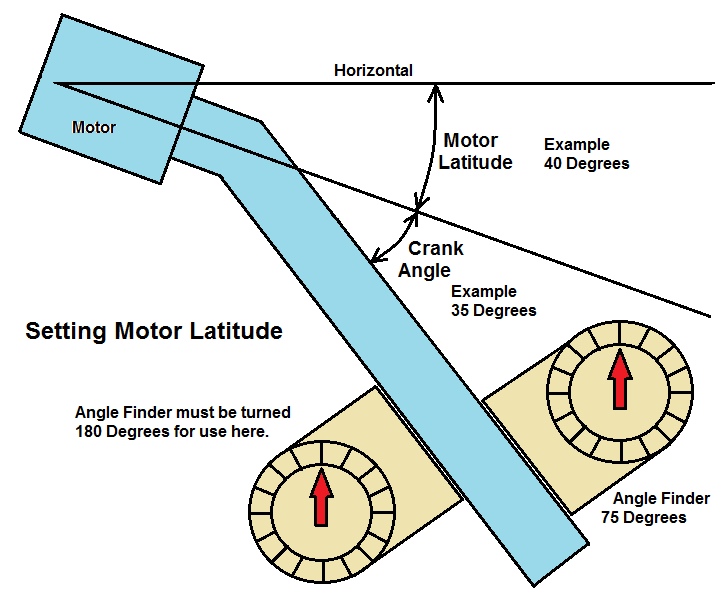
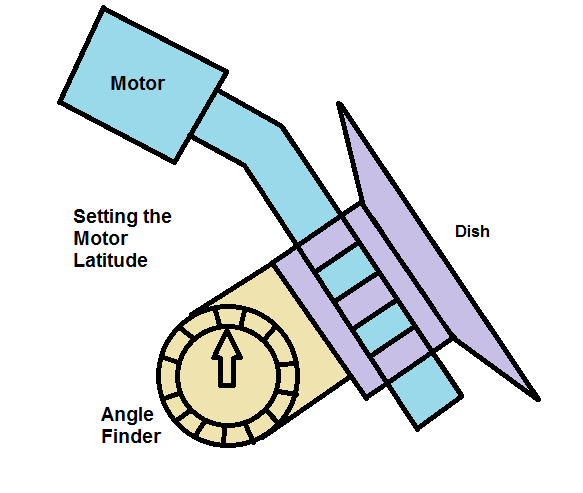
Setting Declination Angle-Small Dish
Small Dish: The declination angle is set using the
elevation scale on the dish. The angle to set on the dish elevation scale is
always: CRANK ANGLE MINUS THE DECLINATION ANGLE. For example if the crank angle
is 35 and the declination is 5.8 then the elevation scale is set to 29.2. This
angle is not as critical because it will be finalized by tuning in the nearest
south satellite. You could use the angle finder to set the declination angle but
you would have to know the offset angle of the dish.
Setting the Motor Latitude and Declination
Angle-Large Dish
Large Dish: See picture below. Use an angle finder on the
rotational axis and set the motor latitude angle using the motor latitude
adjuster (sometimes referred to as elevation adjuster). Angle finder A is
setting the motor latitude. Angle finder B is setting the declination angle. Use
the declination adjuster to set the declination. The difference in the angle
finder readings between A and B is the declination angle. For example if you
need a declination angle of 5 degrees and angle finder A (measuring the motor
latitude) is showing 35 degrees above horizontal, then angle finder B (measuring
the declination angle) should show 40 degrees above horizontal. You only need one
angle finder.
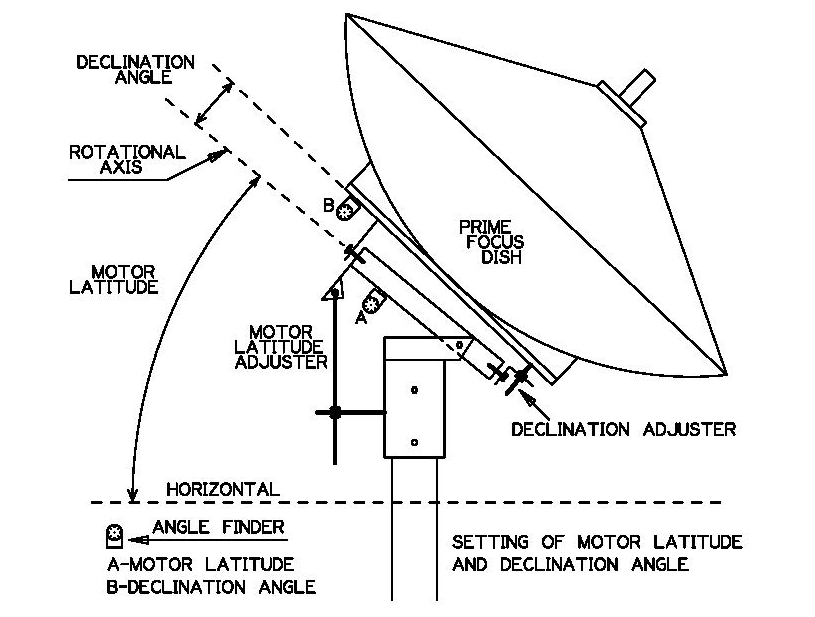
Alternate Method for North/South Alignment of
Small Dish with USALS Function
Your receiver must have USALS function for the following to work. After
motor latitude and declination angle are set, connect wire from receiver to
motor. Make sure the receiver is off and unplugged before making any
connections. Using the receiver, cause the motor to go to "0" or reference
position. Enter your latitude and longitude location. Now using the USALS
function make the antenna go to your nearest south satellite. The motor will
turn the antenna. DO NOT USE THE MOTOR AGAIN UNTIL AFTER NEAREST SOUTH SATELLITE
IS TUNED IN.
Initial Pointing to Nearest South Satellite
You will need a starting point to begin looking for the nearest south satellite.
You can use a magnetic compass for rough setting.
Dishpointer.com gives you the
corrected magnetic azimuth angle. Also
Dishpointer.com can show you where to point the antenna in your neighborhood
for your nearest south satellite. Move the little teardrop pointer to where you
want to install the dish. If there is something along the line shown that you
can use for a reference point, use that for initial pointing. Stand at the dish
and look toward your reference point. Put a marker on the ground about 15 feet
from the dish lined up with the reference point. If you can't find any reference
point in your neighborhood from Dishpointer.com, you could set a true south
marker using the sun. Go here for explanation how to use the sun to set a true
south marker: Setting A True
South Marker
Tune in the Nearest South Satellite
Point the antenna dish at your reference point. If using a ground marker, stand
behind the marker looking at the antenna. Turn the entire polar mount/motor/dish
antenna assembly on the mast until it is pointing straight at you. When the dish
is pointing straight at you the LNB will appear centered vertically on the dish. DO NOT USE THE MOTOR TO TURN THE ANTENNA. You
might want to hook the receiver straight to the LNB and bypass the motor to make
absolutely certain the motor does not activate and turn the antenna while you
tune to the nearest south satellite. Turn on your receiver and tune to an active
transponder that you know is on your nearest south satellite. To find an active
transponder, use a list of satellite channels on the internet or ask at a forum
like Legal Free to Air. You may have to
manually enter the Frequency, Polarization, and Symbol Rate of the active
transponder. Begin to look for the nearest south satellite. Remember do not use
the motor/linear actuator to turn the antenna, but turn the entire polar
mount/motor/antenna assembly on the mast. If after turning left and right a
little and you don't find the satellite, adjust the elevation of the antenna up
or down in steps of about 1 degree and keep looking. For large dish C band, use
the declination adjustor for this small elevation adjustment.
After you find the satellite, do a scan and verify that you are at the correct
satellite.
Now tune for maximum signal quality by adjusting the azimuth.
DO NOT
USE THE MOTOR FOR THIS INITIAL TUNING. Turn the entire polar mount/motor and
dish assembly left and right on the mast for maximum signal quality. Now tighten
the bolts that hold the polar mount/motor to the mast while watching the signal
quality. Do not over tighten, you may damage the mast.
Now tune for maximum signal quality by adjusting the elevation.
Small Dish: Adjust the dish elevation up and down for
maximum signal quality. Do not move motor latitude at this time. Tighten the bolts
while watching signal quality. Connect the receiver to the motor and LNB and set
this as one of your antenna positions so you can return easily to this position.
Always turn off and unplug the receiver before making connections. After the
nearest south satellite is tuned in you could switch off USALS and return to
manual movement and setting of satellite positions if you wish.
Large Dish: Use the declination adjustor to fine tune and
obtain maximum signal quality at nearest south satellite. Do not move the motor
latitude adjuster for this tuning.
Simple Small Dish Elevation Adjusting Tool
Below in the picture is a simple add-on tool for adjusting dish elevation. Parts
needed are:
● Short length of 1-1/4 inch PVC plumbing pipe
● 45 degree fitting, 1-1/4 inch PVC
● Turnbuckle
● Hose clamp
● Cable ties
The 45 degree fitting goes on the end of a 42mm motor tube and secured with the
hose clamp. Cut 4 hack saw cuts in the fitting where it slips over the motor
tube so the hose clamp can tighten it on the motor tube. Turnbuckle is secured
with cable ties. On the pipe, I drilled a hole on each side of the turnbuckle
and passed the cable tie through the holes and the turnbuckle eye. You could
also just attach the turnbuckle around the pipe with 2 ties and pull very tight.
A smaller turnbuckle higher up with a shorter pipe would work also. Don't forget
to loosen the screws before trying to adjust elevation.
Adjustment for Tracking the Satellite Arc
Now using the motor or linear actuator turn the antenna and try to find
the furthest east or west satellite that you wanted. Make sure you are tuned to
an active transponder on the satellite. Make sure the transponder is
broadcasting to your area and in a format that your receiver works with. A DVB-S
receiver will not find DVB-S2 signals. Watch the signal meter while turning the
antenna.
After finding the satellite, use the motor, and move east and west for maximum
signal quality. If you have trouble finding the furthest east/west satellite,
then find a satellite closer to south to begin tracking adjustment.
Now very carefully using the dish elevation adjustment for a small dish or the
declination adjustor for a large dish, check to see which direction up or down
you need to move the antenna to INCREASE
the signal quality. Do not change the motor latitude at this point.
If a DOWNWARD movement
INCREASES signal quality, that
means your track is ABOVE the
satellite arc.
If an UPWARD movement
INCREASES signal quality, that
means your track is BELOW the
satellite arc.
Write down which side of south you are on, east or west, and write down if your
track was above or below the satellite arc.
Return to the nearest south satellite and retune if necessary, returning the
adjuster to where it was. Now find a satellite on the opposite side of south. It
should need the same downward or upward movement to increase signal quality as
the first satellite. If your track is above the satellite arc on one side
and below the satellite arc on the other side, your north/south alignment
is off. Correct north/south alignment before proceeding. See North/South
Alignment Problems below.
Return to the nearest south satellite to make Motor Latitude Adjustment.
![]()
The following adjustment is made with the antenna at the
nearest south satellite position. If you were ABOVE
the satellite arc, make this adjustment: DECREASE
your motor latitude. You decrease the motor latitude by moving the rotational
axis towards horizontal. Check the angle carefully before loosening the motor
latitude adjustment screws and move a small amount towards horizontal. DO NOT
loosen the bolts holding the motor bracket to the mast.
For this adjustment, you could just stick the magnetic base of the angle finder
in the front center of the dish and take a reading. The direction of movement
needed will appear as a raising or increase of elevation. Do not adjust more
than one degree. Remember you are adjusting Motor Latitude. After moving,
tighten the motor latitude adjustment screws. Check carefully that the new angle
is moved slightly in the right direction from the first angle you found. If not
correct, redo the adjustment.
Now tune for maximum signal quality using the dish elevation movement for small
dish and declination adjuster for large dish and tighten the screws. This
re-tuning will automatically increase the declination angle. Any east/west
movement is done using the motor. Remember this adjustment procedure is done at
the nearest south satellite.
Return to the furthest east or west satellite where you were before. Check again
to see which direction up or down you need to move the antenna to increase the
signal quality. Repeat adjustment process if necessary. When you can turn the
antenna from the nearest south satellite to the furthest east/west satellite,
and have maximum signal quality then you know the adjustment is correct.
![]()
The following adjustment is made with the antenna at the
nearest south satellite position. If you were BELOW
the satellite arc, make this adjustment: INCREASE
your motor latitude. You increase the motor latitude by moving the rotational
axis away from horizontal. Check the angle carefully before loosening the motor
latitude adjustment screws and move a small amount away from horizontal. DO NOT
loosen the bolts holding the motor bracket to the mast.
For this adjustment, you could just stick the magnetic base of the angle finder
in the front center of the dish and take a reading. The direction of movement
needed will appear as a lowering or decrease of elevation. Do not adjust more
than one degree. Remember you are adjusting Motor Latitude. After moving,
tighten the motor latitude adjustment screws. Check carefully that the new angle
is moved slightly in the right direction from the first angle you found. If not
correct, redo the adjustment.
Now tune for maximum signal quality using the dish elevation movement for small
dish and declination adjuster for large dish and tighten the screws. This
re-tuning will automatically decrease the declination angle. Any east/west
movement is done using the motor. Remember this adjustment procedure is done at
the nearest south satellite.
Return to the furthest east or west satellite where you were before. Check again
to see which direction up or down you need to move the antenna to increase the
signal quality. Repeat adjustment process if necessary. When you can turn the
antenna from the nearest south satellite to the furthest east/west satellite,
and have maximum signal quality then you know the adjustment is correct.
North/South Alignment Problems
![]()
If during the adjustment procedure, you find you are above
the arc on one side of south and below the arc on the other side of south, then
your north/south alignment is off. You will have to turn the entire polar
mount/motor/antenna assembly on the mast. Turn towards the side where your track
is below the arc.
Go here for a one page adjustment guide that you can print out: http://www.repentnow.com/adjustsatellitearc2.pdf